Sikorsky CH-53 Sea Stallion
| CH-53 Sea Stallion | |
|---|---|
 | |
| General information | |
| Type | Heavy-lift cargo helicopter |
| National origin | United States |
| Manufacturer | Sikorsky Aircraft |
| Status | In service |
| Primary users | United States Marine Corps (historical) |
| History | |
| Manufactured | 1964–1978 |
| Introduction date | 1966 |
| First flight | YCH-53: 14 October 1964 |
| Retired | 2012 (USMC)[1] |
| Variants | HH-53 "Super Jolly Green Giant"/MH-53 Pave Low |
| Developed into | Sikorsky CH-53E Super Stallion Sikorsky CH-53K King Stallion |
The CH-53 Sea Stallion (Sikorsky S-65) is a family of American heavy-lift transport helicopters designed and built by the American manufacturer Sikorsky Aircraft. The Sea Stallion was originally developed in response to a request from the United States Navy's Bureau of Naval Weapons made in March 1962 for a replacement for the Sikorsky CH-37 Mojave helicopters flown by the United States Marine Corps (USMC).
In July 1962, Sikorsky's proposal, which was essentially a scaled-up S-61R fitted with twin General Electric T64 turboshaft engines and the dynamic systems of the S-64/CH-54, was selected. On 14 October 1964, the YCH-53A performed its maiden flight; the first deliveries of production CH-53s to operational units commenced on 12 September 1966. The first combat use of the type occurred during the following year when it was deployed to the Vietnamese theater; the CH-53 quickly proved its value for moving heavy payloads, particularly in the recovery of damaged aircraft.
Several variants of the type were promptly introduced. The United States Air Force introduced the HH-53 "Super Jolly Green Giant", configured for special operations and combat search and rescue (CSAR) missions, during the latter part of the Vietnam War; the majority of these were subsequently rebuilt into the MH-53 Pave Low. The visually similar CH-53E Super Stallion is a heavier-lifting improved version of the rotorcraft, designated S-80E by Sikorsky; its third engine makes it more powerful than the Sea Stallion and thus displaced it for the heavy-lift mission. Furthermore, many early-build CH-53s were refitted with more powerful engines, while others were reconfigured for different mission roles, such as US presidential flights, training, and airborne mine countermeasures (AMCM) operations.
Several export deals for the CH-53 were made, leading to several international operators of the type. Among these are Germany, Iran, and Israel. Several unusual or high-profile operations have been undertaken, such as the capture and transportation of a Soviet advanced radar system to Israel under Operation Rooster 53 in 1969, and Iran's capture of five American CH-53s as a result of Operation Eagle Claw in 1980. Various operators deployed their CH-53s during international missions, often under the auspices of NATO or the United Nations, such as for UNSCOM in Iraq, in Kosovo with Kosovo Force (KFOR), Implementation Force (IFOR) in Bosnia and Herzegovina, and the International Security Assistance Force (ISAF) in Afghanistan. While several operators have opted to retain the type into the twenty-first century, many others have opted to supplement or withdraw their Sea Stallions in favor of other platforms, sometimes with the more powerful CH-53E. The CH-53 remains in service with German and Israeli forces, and is one of the largest military helicopters in service. Germany is planning to replace its fleet, as of the 2020s, with the latest version of the twin-rotor CH-47 Chinook. The latest version of the CH-53, the K model King Stallion is in production as of the 2020s entering service with the United States Marine Corps; this is replacing the Super Stallion, itself an upgraded version of Sea Stallion. The heavily upgraded Jolly Green Giant and Pave Low versions of the CH-53 were retired by 2008, flown by the U.S. Air Force for combat search and rescue. Overall, the CH-53 was replaced in many roles by the V-22 Osprey tilt rotor in U.S. service.
Development
[edit]Origins
[edit]In 1960, the United States Marine Corps (USMC) began to seek a replacement for their HR2S piston-powered helicopters. On 27 January 1961, the USMC began working with the U.S. Army, Navy, and Air Force on the "Tri-Service VTOL transport", which would eventually emerge as the LTV XC-142 tiltwing.[2] The design became more elaborate and the program stretched out, causing the USMC to drop out when they decided they would not receive a working machine in a satisfactory timeframe. In particular, there were concerns that the high levels of downwash produced by the XC-142A would render shipborne operations impractical.[2] In the end, the XC-142A, although a very innovative and capable machine, never entered production.[3]
In March 1962, the United States Navy's Bureau of Naval Weapons, acting on behalf of the USMC, issued a request for a "Heavy Helicopter Experimental / HH(X)".[2] The specifications dictated a load capability of 8,000 pounds (3,600 kg) with an operational radius of 100 nautical miles (190 km; 120 mi) at a speed of 150 knots (280 km/h; 170 mph). It was also specified to possess a higher top speed and greater lifting capacity than existing helicopters while also having a lower empty weight than preceding designs as well.[4] The HH(X) was to be used in the assault transport, aircraft recovery, personnel transport, and medical evacuation roles.[2] In the assault transport role, it was to be mostly used to haul heavy equipment instead of troops.[3]

In response, Boeing Vertol offered a modified version of the CH-47 Chinook; Kaman Aircraft offered a development of the British Fairey Rotodyne compound helicopter; and Sikorsky offered what amounted to a scaled-up version of the S-61R, with twin General Electric T64 turboshaft engines and the dynamic system of the S-64/CH-54, to be designated the S-65.[2] Kaman's proposal quickly died when the British government dropped its backing of the Rotodyne program. Competition between Boeing Vertol and Sikorsky was intense, with the Chinook having an advantage because it was being acquired by the United States Army.[3] During July 1962, it was announced that Sikorsky's bid had been selected as the winner on account of various considerations, including cost, technical factors, and production capability. However, a contract was not immediately forthcoming due to budgetary limitations.[2]
The USMC had originally sought to procure four prototypes.[2] However, in light of funding shortfalls, Sikorsky, determined to keep the deal, reduced their estimate for the program's development costs by proposing that development could be performed with only two prototypes. Military officials favorably received the company's proposed reduction; in September 1962, Sikorsky was awarded a $9,965,635 (~$76.9 million in 2023) contract for the production of a pair of YCH-53A prototypes, as well as a mockup and a ground-test airframe.[2]
The development program did not go entirely smoothly, due to a shortage of engineering resources plus various failures of subcontractors and the government, but these problems were gradually overcome. There was also pressure against the program from U.S. Secretary of Defense Robert S. McNamara, who promoted the concept of "commonality" between the armed services by adopting the Chinook instead. However, the USMC managed to convince McNamara's staff that the Chinook could not meet their requirements without numerous expensive changes.[3]
The first YCH-53A performed its initial flight at the Sikorsky plant in Stratford, Connecticut, on 14 October 1964, about four months behind schedule.[2] During the previous month, the USMC had already placed an initial production contract for 16 helicopters. Flight trials went more smoothly than expected, helping make up for the time lost in development; on 19 November 1964, the type was formally introduced to the general public.[2] Around this time, it received the military designation and name CH-53A Sea Stallion. On 12 September 1966, the first deliveries of the CH-53 to an operational unit occurred.[5][2]
Further development
[edit]
The CH-53A arrived in Vietnam in January 1967 and proved useful, eventually recovering even more downed aircraft than the CH-54. A total of 141 CH-53As were built, including the two prototypes.[3] The U.S. Navy acquired 15 CH-53As from the USMC in 1971 for airborne mine countermeasures (AMCM) activities. The helicopters had more powerful T64-GE-413 turboshafts installed and received the designation RH-53A.[3]
The United States Air Force ordered the HH-53B in September 1966 and it first flew on 15 March 1967. It added a refueling probe, drop fuel tanks and a rescue hoist; it also featured upgraded T64-GE-3 engines. The Air Force used the HH-53B for combat search and rescue (CSAR).[6] HH-53C was an improved CSAR variant with a smaller 450 US gallons (1,700 L) fuel tank in exchange for more armor and better communication systems. The CH-53C was similar except it lacked a refueling probe. It was used by the USAF for more general transport work.[7]
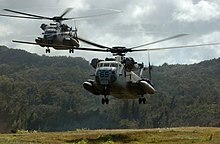
Heavy lifting in tropical climates demanded more power, so the USMC decided to acquire an improved variant, the CH-53D, with uprated engines, originally the T64-GE-412 then later the T64-GE-413. The CH-53D also included an uprated transmission to go with the more powerful engines, and a revised interior to permit a load of 55 troops.[3]
The initial flight of the CH-53D was on 27 January 1969. The CH-53D served alongside the CH-53A through the rest of the Vietnam War. A VIP transport version designated VH-53D with plush accommodations was used by the USMC for the US presidential flights.[3] The US Navy also acquired CH-53D-based helicopters for minesweeping. These were designated RH-53D and included mine sweeping gear such as a pair of 0.50 BMG (12.7 mm) Browning machine guns for detonating mines. The Navy received 30 RH-53Ds beginning in 1973. After the RH-53Ds were in service, the RH-53As were handed back to the USMC and restored to CH-53A configuration.[3]
During the 1980s, Israeli Air Force's CH-53 Yas'ur fleet was upgraded by Israel Aircraft Industries and Elbit Systems. The project – which ended only in 1997 – improved the CH-53 avionics, robustness and extended its life span by at least two decades.
In 1989, some of the CH-53As being retired by the USMC were passed on to the U.S. Air Force for training, with these helicopters redesignated TH-53As. The TH-53As were stripped of most operational equipment and painted in USAF camouflage colors.[3]
Design
[edit]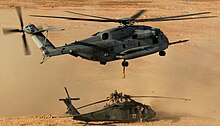
The Sikorsky CH-53 Sea Stallion is a heavy lift military transport helicopter. The CH-53A carries a crew of four; pilot, copilot, crew chief, and an aerial observer. It can carry various payloads, including up to 38 fully-equipped troops, 24 litters with medical attendants, an internal cargo load of 8,000 pounds (3,600 kg), or an external load of 13,000 pounds (5,900 kg) on the single-point sling hook.[2] Access to the main cabin is via the large passenger door on the right side of the fuselage behind the cockpit, as well as by a power-operated loading ramp to the rear.[3] This loading ramp was capable of facilitating drive-on loading operations, enabling quicker cargo movements. The CH-53A was designed to have a useful payload capacity, in terms of weight, of almost half of the rotorcraft's empty weight.[4]
It is provisioned with mechanical flight controls, which are backed by three independent hydraulic systems.[3] As noted by Sikorsky engineer Edward S Carter Junior, the rotorcraft could be equipped to facilitate all-weather operations.[4] It shares a somewhat similar fuselage design, albeit on a substantially larger scale, with the Sikorsky S-61R series. While the Sea Stallion's fuselage is watertight, the helicopter is not intended for amphibious use and its ability to land on water is meant to only be used in emergency situations. To save space, which is normally at a premium on board most naval vessels, both the tail boom and the rotors can be folded while the helicopter is stowed; to reduce the workload involved in this process, an automated folding system was developed by Sikorsky.[4] Both the crew and vital systems are protected by armoring across key areas. All of the fuel was housed within sponsons on either side of the fuselage.[2] The CH-53A was typically equipped with a pair of 7.62×51mm NATO M60 machine guns that point out to each side of the fuselage.[3]
The CH-53A features a fully-articulated six-bladed main rotor and four-bladed tail rotor.[2] According to Carter, the relatively high speed requirement stipulated by the USMC was the primary factor shaping the dynamic design.[4] While the Sea Stallion's dynamic systems were largely derived from those used on the earlier Sikorsky S-64 Skycrane, substantial reengineering were also involved due to the vastly different operating requirements. Extensive use of titanium was made across its dynamic components, particularly for elements that may have been susceptible to degradation over time due to metal fatigue.[4] Initially, the CH-53 was powered by a pair of General Electric T64-6 turboshaft engines, each of which provided up to 2,850 shaft horsepower (2,130 kW). These engines were located on the upper fuselage. Later engines included the T64-1, capable of generating up to 3,080 shp (2,300 kW), and the T64-16, which was rated for up to 3,485 shp (2,599 kW).[3] The HH-53B model featured T64-3 engines, which produced up to 3,080 shp (2,300 kW).[7]

The improved CH-53D features uprated engines, initially using the T64-GE-412 that could provide up to 3,695 shp (2,755 kW), then the T64-413 with its further elevated output of 3,925 shp (2,927 kW); these more powerful engines necessitated the use of an uprated transmission. Interior changes included additional seats, which allowed for up to 55 troops to be carried at a time. The CH-53D is generally armed with twin .50 BMG (12.7 mm) M2/XM218 machine guns. During the type's later years of service, it has become commonplace for CH-53Ds to have been retrofitted with various defensive countermeasures; such apparatus has often included an AN/ALE-39 chaff dispenser and an AN/ALQ-157 infrared countermeasure.[3]
Later production CH-53Ds featured a Blade Inspection Method (BIM) scheme to detect cracks in its metal rotors. BIM involved pressurizing the interior of the rotor blades with nitrogen. If a crack is present pressure is lost and a red indicator on the rotor blade tip was tripped. Later, the BIM system was connected to a cockpit display. BIM reduced the need to routinely swap rotor blades.[3]
Operational history
[edit]United States
[edit]
The CH-53/HH-53 has seen considerable use in warzones and served in various conflict during its service. It was first used in the Vietnam War, often recovering downed aircraft and evacuating personnel. The CH-53D served alongside the CH-53A through the latter portion of the US's presence in Vietnam; both types played a critical role at the end of the conflict, performing evacuations of personnel during Operation Frequent Wind.[8]
U.S. Air Force HH-53 Super Jolly Green Giants were the primary search-and-rescue helicopter in Southeast Asia between 1967 and 1975, inserted the Operation Ivory Coast rescue team into the North Vietnamese prison camp at Son Tay in 1970, and carried the USMC and Air Force Security Forces who attempted to rescue the crew of SS Mayagüez.[9][8][10] Marine-flown Navy Sea Stallions were the rotary-wing element of Operation Eagle Claw, the attempted rescue of American hostages in Iran in 1980 that ended in disaster and embarrassment at "Desert One".[11][12] Marine CH-53s were used in Grenada during Operation Urgent Fury.[13]

The CH-53 was operated by the Air Force, Marine Corps and Navy in support of Operation Iraqi Freedom. It is also operated by all three services in support of Operation Enduring Freedom in Afghanistan. It was in the Afghan theatre than the final operational missions of the CH-53D fleet were performed during February 2012.[14]
On 17 September 2007, VMM-263 of the USMC was deployed with ten MV-22B Ospreys, a tiltrotor aircraft.[15] The V-22 has been the primary replacement for the USMC's fleets of CH-53Ds and CH-46E Sea Knights, but not the more powerful CH-53Es; instead, the in-development CH-53K is planned to supplant the Navy and USMC CH-53E fleets.[16][17]

During September 2011, HMH-463 replaced its CH-53Ds with CH-53Es. HMH-363 and HMH-362 are to operate D-models until the squadrons are deactivated. Both units are to be reactivated as MV-22 and CH-53K squadrons respectively. Several CH-53D helicopters will be retained for the 3rd Marine Regiment for training.[18][19] HMH-362 retired the last CH-53Ds after its combat deployment in August 2012 and decommissioned in November 2012.[20]
Israel
[edit]In August 1968, an Israeli Air Force (IAF) delegation visited Sikorsky's Connecticut plant while seeking information to select the service's next assault helicopter.[21] The delegation was looking for a helicopter with augmented payload carry capacity, highly maneuverable and robust, that could survive direct hits from different caliber projectiles. They examined Boeing's CH-47 Chinook and Sikorsky's CH-53, it was recognised that the latter was both larger and stronger than any of the IAF's other helicopters, and thus represented a major advancement in terms of capability. Based upon experience gained from the intense combat of the then-recently fought Six-Day War, the delegation opted to favor the CH-53.[21]

On 2 October 1969, the first S-65C-3 (CH-53D) helicopters were delivered to Israel of an initial order of seven.[2] At the time, the country was engaged in the War of Attrition, and thus the type was quickly dispatched into combat. Receiving the Hebrew name Yas'ur (Petrel), a further 35 helicopter were delivered to fulfil subsequent orders.[2] On 6 August 1970, the first Yas'ur squadron was established. For several decades, the type has served as the primary cargo helicopters of the IAF, being routinely used to carry both troops and heavy equipment.[citation needed]
In 1969, during the War of Attrition, IAF CH-53s landed in Egypt and conveyed a captured Soviet advanced radar system back to Israel for examination by Israeli scientists and engineers (see Operation Rooster 53).[22] The Yas'ur was also used in various other capacities during the conflict, including the retrieval of a navigator from a downed IAF F-4 Phantom II under sustained enemy fire on 30 June 1970.[21]

During the 1973 Yom Kippur War, the Yas'ur routinely moved artillery batteries and for the insertion of IDF units around the fronts. The type was also used to evacuate hundreds of wounded soldiers and rescued pilots from behind enemy lines in both Egypt and Syria.[21] In one engagement, a single Yas'ur was attacked by multiple aircraft, including a pair of MiG-21s; while sustaining damage, it was still able to return to base. Since 1973, Yas'urs have also been used by the IDF to land and extract Sayeret commandos on raids and patrols deep behind enemy lines in Lebanon Syria and the greater Middle East.[21]
During the 1980s, Israel Aircraft Industries, along with Elbit Systems, commenced a major upgrade program for the IAF Yas'ur fleet. The project, which was completed in 1997, improved the CH-53's avionics and increased its robustness, as well as extending the fleet's operating life by at least two decades.[citation needed]
In 1989, several Yas'urs were used to perform firefighting operations on and around Mount Carmel. They performed dozens of low flyovers into the smoke and flames, dumped 700 tons of water on the fire, and doused it. On 8 November 1992, a pair of CH-53s performed one of the IAF's longest-distance sea rescue operations to retrieve passenger from the distressed yacht Fantasy 2 off the coast of Sudan.[21]
During the 2006 Lebanon War, Hezbollah shot down an Israeli CH-53 Yas'ur with an anti-tank missile, killing five air crew members.[23][24] This was reportedly the only combat loss of an Israeli CH-53 during this conflict.[25][26]
On 16 August 2012, the IAF temporarily grounded its CH-53 fleet following one having experienced in-flight difficulties that led to an emergency landing; initial reports state the issue was related to the rotor blades.[27] The fleet was again grounded for three weeks after a CH-53 was destroyed by a fire during a training exercise; the IAF subsequently attributed this loss to a defective component and blamed Lockheed Martin for failing to communicate the issue.[28]
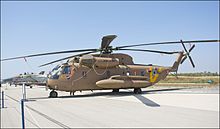
During 2015, it was announced that Israel planned to withdraw the last of its Yasurs around 2025.[29] Replacement options studied included the CH-53K and the CH-47F Chinook, with a prospective order for approximately 20 helicopters being placed for the preferred option.[30] During February 2021, the Israeli Ministry of Defense announced the selection of the CH-53K to replace the Yasur fleet.[31][32]
On 7 October 2023, during the first day of the Israel-Hamas war, and the first time since the 2006 Lebanon War in a similar incident, Hamas shot down an IAF CH-53 with an anti-tank rocket and hitting its left engine, while carrying about 50 paratroopers (a very unusual procedure, as opposed to the approved IAF's max capacity of 33 troops).[33] The pilot managed to land safely in an open field, offloading both the aircrew and the paratroopers. The CH-53 was then hit by a second anti-tank rocket, completely destroying the helicopter. The occupants survived the attack with minor to medium injuries.[34][35][36]
Iran
[edit]
During the 1970s, an initial fleet of six RH-53D Sea Stallions was delivered to the Imperial Iranian Navy (IIN). Following the Iranian Revolution in 1979, the Sea Stallions continued in service with the renamed Islamic Republic of Iran Navy (IRIN).[5] These were supplemented by five U.S. Navy examples that were abandoned during Operation Eagle Claw in 1980.[37] Despite US sanctions that have blocked the nation from acquiring spares and support from overseas, Iran has reportedly been able to keep at least a portion of their Sea Stallions in an operational condition; this effort has been aided by illegal exports of controlled parts to Iran by US citizens.[38][39]
Germany
[edit]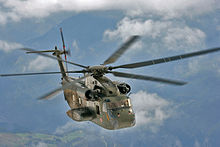
In 1966, the German military evaluated both the CH-53 and CH-47 as a replacement for the H-21 and H-34G helicopters with an initial requirement for 133.[40] The purchase of the CH-53 was approved in June 1968 but due to budget constraints only 110 were ordered.[40] Following the delivery in 1969 of two pre-production helicopters from Sikorsky the production aircraft were licence built by VFW-Fokker at Speyer in Germany.[40] The first German-built CH-53G Mittlerer Transporthubschrauber helicopter flew from Speyer on 11 October 1971 and was delivered to the Erprobungsstelle der Bundeswehr 61 flight test center at Manching on 1 December 1971.[40]
The German Army Aviation Corps received 110 type CH-53Gs, derivatives of the CH-53D, between 1971 and 1975. 108 helicopters were built in Germany by VFW-Fokker. The first flight by a German CH-53G was made in 1971, followed in March 1973 by the delivery of the first machines to Heeresfliegerregiment (HFlgRgt, Army Aviation Corps Regiment) 35 in Mendig, and shortly afterwards to the newly formed Army Aviation Corps Regiment 15 based at Rheine and Army Aviation Corps Regiment 25 based at Laupheim.[citation needed]

To meet ever more demanding specifications, over time the CH-53G received modifications from 1990 designed to improve its service life and operational capabilities. These involved three major upgrades: new missile warning and self-protection systems; provision for two external fuel tanks allowing range to be increased to 1,100 mi (1,800 km) when carrying 36 armed soldiers or a 12,100 lb (5,500 kg) payload; and addition of a night vision goggles-compatible cockpit for night low-level flying capabilities. All CH-53Gs were upgraded by Eurocopter Germany by early 2001, resulting in updated GS/GE/GA variants. As a result of foreign military operations 20 CH-53G helicopters were converted to perform Combat Search and Rescue (CSAR) missions. Version CH-53GS is equipped with modernized IFR equipment, additional exterior fuel tanks, low-flight night vision cockpit and NVG, partial ballistic protection, engine dust collectors, missile counter measure and self-defence armament. Additionally the original engines were replaced by the more powerful T64-100 engines.[citation needed]
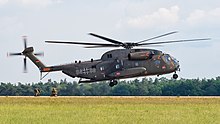
German Army Aviation Corps units have carried out a wide range of international missions under the auspices of NATO and the UN, providing transport for members of UNSCOM in Iraq, serving in Kosovo with KFOR, with IFOR in Bosnia and Herzegovina, and more recently with ISAF in Afghanistan.[citation needed] On 1 January 2013, all Army Aviation Corps CH-53Gs were transferred to the German Air Force and incorporated into Helicopter Wing 64.[41]
During the 2010s, Germany was reportedly considering options for replacing its aging CH-53G fleet, with candidates including the Chinook and the CH-53K model. On 29 September 2020, the German Ministry of Defense cancelled the "Schwerer Transporthubschrauber" (STH) heavy-lifting helicopter program for 45 to 60 helicopters after the initiative was judged to be too expensive and stated that its CH-53Gs fleet would be replaced following a period of reexamination.[42][43] In 2022, the Federal Government announced that all of Germany's CH-53s would be replaced by 60 CH-47Fs.[44]
Austria
[edit]
During 1970, a pair of S-65C-2 or S-65Ö (equivalent to the CH-53D standard, albeit without the aerial refuelling probe) helicopters were delivered to Austria. Intended primarily to perform airborne rescue operations in the Alps, they were assigned to 1st Helicopter Wing of the Austrian Air Force, making the service the second foreign operator of the CH-53.[2] Their equipment included same rescue hoist as the HH-53 and fittings for auxiliary fuel tanks and accommodation for 38 passengers. Although they performed well in high altitude operations, the type's relatively high operating costs were a major contributing factor in Austria's decision to sell both rotorcraft to Israel in 1981.[2] However, since the 1999 Galtür avalanche, in which over 7000 thousand people had transported by international collaboration of helicopter resources from Austria, USA, German, France, and Switzerland including 50 helicopters, more helicopter resources have been pursued.[45]
Mexico
[edit]During 2003, the Fuerza Aérea Mexicana (FAM) acquired four surplus CH-53D Sea Stallions from Israel at a combined cost of $25 million (~$39.7 million in 2023).[46][47] Prior to their delivery in 2005, all helicopters were upgraded to the Yasur 2000 standard. Due to restricted budgets, only two were actually operated by 104th Air Squadron, while the other pair served as a source of spare parts. Their initial missions were troop transport and commando insertion, but their principal mission was subsequently changed to performing rescue and disaster relief operations, being relocated to BAM 8 at Yucatán. By 2013, all examples had been permanently withdrawn from service.[48]
Civil use
[edit]During 2007, the first commercially owned CH-53D was being converted by the Californian company Heavy Lift Helicopters into a firefighting configuration, which was referred to by the firm as the Fire Stallion Having acquired a batch of six ex-military CH-53Ds, the company planned to make them available for hire by other operators; in addition to fire-fighting, construction work and general transport duties were envisioned for the fleet.[49] While the fleet reportedly flew for a handful of years, they entered storage after only a short period of use due to component shortages.[50]
Variants
[edit]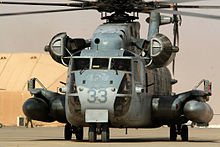
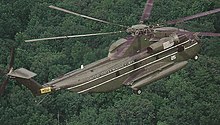

- YCH-53A
- Two prototypes with two 2,850 shp (2,130 kW) T64-GE-3 engines.
- CH-53A
- Initial production variant for the USMC. 139 built.
- RH-53A
- CH-53A re-engined with two 3,925 shp (2,927 kW) T64-GE-413 engines as Airborne Mine CounterMeasures (AMCM) variants for the United States Navy. 15 conversions.
- TH-53A
- Stripped CH-53As used for training by the United States Air Force.
- CH-53D
- CH-53A with an improved transmission, larger cabin for 55 troops and automatic rotor blade folding for the United States Marine Corps, 126 built.
- RH-53D
- United States Navy AMCM variant of the CH-53D, fitted with 0.50-inch caliber machine guns and provision for air refueling. 30 built for the USN. Six examples were also exported to Iran, before the Iranian Revolution in 1979.[5] This version can carry 25,000 lb (11,340 kg) of cargo with cargo hook.[51]
- VH-53D
- Four modified CH-53Ds for USMC VIP transport.[citation needed]
- VH-53F
- Six unbuilt VIP helicopters for the US Navy/Marine Corps.
- CH-53G
- German base version of the CH-53D for the German Army Aviation Corps. The internal Sikorsky designation was S-65C-1.[52] A total of 112 were produced including 2 pre-production and 20 assembled by VFW-Fokker and 90 built by Speyer.[53] As of 2007[update], 89 German CH-53s were in service, with 80 planned to be in service in 2014. All German CH-53s are going to receive T64-100 engines (in 3 batches; first batch has already been installed, second batch is currently being installed and 3rd batch is planned with funding made available). All will receive IFR-capability.[54]
- CH-53GS
- Update of 20 CH-53Gs in the late 1990s, with additional missile counter measure, upgraded communication and navigation system and two external fuel tanks added.[53] They later received the first batch of T64-100 engines to operate in hot and high conditions that prevail in Afghanistan. MG3 and M3M machine guns were also fitted.[55] A CH-53GS/GE update has also been ordered to provide combat search-and-rescue (CSAR) capability to 26 helicopters.[56][57][58]
- CH-53GE
- A configuration based on CH-53GS combat search-and-rescue (CSAR) capabilities.[56] The upgrade configuration was formerly known as CH-53GSX.[citation needed] It further updates with modern electronics, two external fuel tanks, counter measures and dust filters for the engines. Upgrade was ordered to support Afghanistan deployment.[55]

- CH-53GA
- Update of further 40 CH-53Gs with new flight deck, new flight control system, autopilot, navigation and communication systems, FLIR, ECM and missile counter measures as well as provisions for additional internal fuel tanks. The CH-53GA helicopter successfully completed its first flight in February 2010.[59] The upgrade was completed by 2013.[60]
- S-65Ö
- Export version of the CH-53D for the Austrian Air Force. Internal Sikorsky designation was S-65C-2. Only 2 were built, subsequently sold to Israel.[52]
- S-65C-3
- Export version of the CH-53D for the Israeli Air Force.[52] The Yas'ur 2000 version are helicopters upgraded and improved by the Israel Aircraft Industries to extend life span past 2000. The Yas'ur 2025 is a further upgraded version with new systems and new gearboxes.[61] Israel completed the upgrade by 2015 and currently operates 21 Yas'urs as of November 2023.[62][63]
Operators
[edit]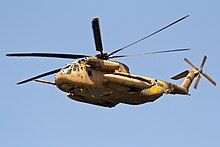
- Israeli Air Force[64]
- 118 Squadron "Night Birds", 1970–present
Former operators
[edit]- Austrian Air Force[65] 1970–1981 (sold to Israel)
- German Army Aviation Corps[66][67]
- Medium Transport Helicopter Regiment 15 Münsterland, 1971–2012 (disbanded)
- Medium Transport Helicopter Regiment 25 Oberschwaben, 1971–2012 (initially disbanded, later reformed in 2013 as Helicopter Wing 64 in the German Air Force)
- Mexican Air Force[48]
- 104th Air Squadron, 2003-2013 (all CH-53s withdrawn from service)
- Israeli Air Force[64]
- 114 Squadron "Night Leaders", 1969–2023 (temporarily inactive, pending reactivation in 2025 while converting to CH-53K King Stallion)
- United States Air Force (see MH-53 Pave Low)
- United States Marine Corps[1]
- HMH-361 "Flying Tigers", 1977–1990 (converted to CH-53E Super Stallion, 1990–present)
- HMH-362 "Ugly Angels", 1969-2012 (Last operational CH-53D Sea Stallion squadron)
- HMH-363 "Lucky Red Lions", 1969-2012 (converted to MV-22 Osprey, 2012-present)
- HMH-366 "Hammerheads", 1994–2000 (converted to CH-53E Super Stallion, 2008–2022)
- HMH-461 "Ironhorse", 1966–1988 (initially converted CH-53E Super Stallion, 2008–2022; subsequently converted to CH-53K King Stallion, 2022-present)
- HMH-462 "Heavy Haulers", 1965–1992 (converted to CH-53E Super Stallion, 1992–present)
- HMH-463 "Pegasus", 1966-2011 (converted to CH-53E Super Stallion, 2012-2022)
- HMH-769 "Titan", 1971–1990 (initially converted to RH-53D Sea Stallion, 1990–1996; later converted to CH-53E Super Stallion, 1996–2008; subsequently will be converted to CH-53K King Stallion in 2026)
- HMH-772 "Hustlers", 1971–2000s (converted to CH-53E Super Stallion, 2000s–present)
- HMH-777 "Flying Armadillos", 1971-1980 (was reformed in 1980 as HMH-772 Detachment B until 1993, and was then consolidated with HMH-769)
- HMHT/HMT-301 "Windwalkers", 1968-1983, 1995-2005 (trained aircrews and technicians on CH-53A/D, converted to CH-53E Super Stallion 1983-1993, reactivated as training unit on CH-53D in 1995 until inactivation in 2005)
- HMHT/HMT-302 "Phoenix", 1987–1995 (trained aircrews and technicians on the CH-53A/D until 1995, today only trains on the CH-53E Super Stallion, 1987–present)
- HMX-1 "Nighthawks", 1972-2004 (Four VH-53D Sea Stallion supported US Presidential Executive Flight Detachment, converted to VH-53E Super Stallion which served into 2011)
- United States Navy[68] (All remaining USN RH-53D Sea Stallions were transferred to the USMC in 1993 and all AMCM USN HM units had converted to the MH-53E Sea Dragon by 1995)
- HM-12 "Sea Dragons", 1971-1994 (reestablished 2015-present with MH-53E Sea Dragon)
- HM-14 "Vanguard", 1978-1989 (converted to MH-53E Sea Dragon 1989-2023)
- HM-15 "Blackhawks", 1993-1994 (established in 1987 as an MH-53E squadron; supported HM-19 as Det. 3 or "Pink Det." integration from RH-53D to MH-53E Sea Dragon)
- HM-16 "Seahawks", 1978-1987 (was exclusively an RH-53D squadron)
- HM-18 "Norsemen", 1986-1995 (RH-53D squadron that integrated with HM-14 with MH-53E Sea Dragon)
- HM-19 "Golden Bears", 1988-1993 (RH-53D squadron that integrated with HM-15 with MH-53E Sea Dragon)
Aircraft on display
[edit]

Israel
[edit]- On display
- 471 (#65-078) - CH-53A on display at Israeli Air Force Museum, Hatzerim Airbase, Israel.[69]
United States
[edit]- On display
- 151686 - CH-53A on display at Paxtuxent River Naval Air Museum, Lexington Park, Maryland.
- 153304 – CH-53A on display at Flying Leatherneck Aviation Museum, MCAS Miramar, California.[citation needed]
- 153715 - CH-53A on display at Fort Worth Aviation Museum, Fort Worth, Texas[citation needed]
- 157159 - CH-53D on display at National Naval Aviation Museum, NAS Pensacola, Florida.[70]
- 158690 - RH-53D on display at Air Victory Museum, Lumberton, New Jersey.
Accidents and incidents
[edit]Due to the aircraft's large size and troop capacity, aerial accidents involving CH-53 helicopters have been some of the deadliest helicopter accidents.
- On 23 June 1967, USMC CH-53A Bu. no #65-082 collided with a US Army UH-1B #63-8572 while taking off from Camp Lejeune, all 20 marines on board were killed along with two occupants of the UH-1B.[71]
- On 8 January 1968, USMC CH-53A #65-100 of HMH-463 crashed in the Hải Lăng Forest south of Đông Hà Combat Base, killing all 46 personnel on board.[72]
- On 19 February 1968, USMC CH-53A #65-055 crashed into Monkey Mountain killing all 13 personnel on board.[73]
- On 22 February 1968, USMC CH-53A #65-060, was hit by antiaircraft fire and crashed at Khe Sanh Combat Base, killing two marines.[74]
- On 1 May 1968, USMC CH-53A #65-058 crashed into the sea off Quảng Trị Province killing one crewman.[75]
- On 28 July 1968, USMC CH-53A #65-061 crashed south of Danang killing all five crewmen.[76]
- On 1 September 1969, USMC CH-53A #65-059 crashed in Thừa Thiên Province killing all five crewmen.[77]
- On 13 September 1970, USMC CH-53D #65-181 was hit by antiaircraft fire and crashed with no fatalities.[78]
- On 26 October 1970, USMC CH-53D #65-192 crashed on a test flight near Danang, killing one crewman.[79]
- On 30 October 1970, USMC CH-53D #65-259 was hit by antiaircraft fire and crashed in Quảng Nam Province, killing two crewmen.[80]
- On 18 February 1971, USAF CH-53C #65-227 of 21st Special Operations Squadron was hit by antiaircraft fire and crashed in Laos with no fatalities.[81]
- On 8 February 1971, USMC CH-53D #65-189 crashed near Huế, killing all nine personnel on board.[82]
- On 1 March 1971, USAF CH-53C #65-229 of 21st Special Operations Squadron was hit by antiaircraft fire and crashed near Long Tieng, killing six personnel.[83]
- On 11 July 1972, USMC CH-53D #65-177 was hit by a surface to air missile and crashed near Quảng Trị, killing three crewmen and 45 South Vietnamese marines.[84]
- On 24 January 1975, USAF CH-53C #65-338 of 21st Special Operations Squadron suffered main rotor head failure and crashed near Nakhon Phanom Royal Thai Navy Base, killing all four personnel on board.[85]
- On 13 May 1975, USAF CH-53C #65-231 of 21st Special Operations Squadron crashed west of Nakhon Phanom Royal Thai Air Force Base, killing 23 Air Force personnel[86]
- On 15 May 1975, during the Mayaguez Incident, three CH-53s of the 21st Special Operations Squadron were shot down by the Khmer Rouge, resulting in the deaths of ten marines, two Navy Corpsmen and two Air Force crewmen.[87]
- On 26 September 1975, USAF CH-53C #65-342 of the 601st Tactical Air Support Squadron crashed near Delbrück (Paderborn) Germany killing 16 personnel on board.
- On 10 May 1977,a CH-53 crashed in Israel, resulting in the deaths of 54 people.
- On 21 October 1977, a CH-53 crashed in Mindoro, Philippines during sling load operations due to a design flaw in the tail rotor drive; 31 US marines serving in Operation Fortress Lightning were killed.[88]
- On 11 December 1978, a CH-53G of the German Army Aviation Corps' Medium Transport Helicopter Regiment 25 crashed at Laupheim Air Base, Germany. During landing in poor visibility the tail rotor hit the ground. Of the four occupants, one was killed.[89]
- On 25 April 1980, six USN RH-53s were lost in Operation Eagle Claw, the failed attempt to rescue American hostages in Iran.
- On 26 November 1980, a CH-53G of the German Army Aviation Corps' Medium Transport Helicopter Regiment 15 crashed in a forest near Wippenkausen, North Rhine-Westphalia, Germany. All four occupants were killed.[90]

- On 14 September 1982, CH-53A #65-083[91] crashed into the North Sea off the coast of Denmark during NATO exercise "Northern Wedding" killing all 5 servicemen aboard.[92] the Pilot, Capt. William H. "Sonny" Coke; Co-Pilot Capt James B. Huff; Crew Chief SSgt. Gary J. "Butch" Lester; Sgt. Timothy A. "Tim" Creighton; and chaplain, Navy Cdr. David R. Morrison. The Sea Stallion was part of Marine Heavy Helicopter Squadron-777.[93]
- On 27 April 1983, a CH-53D crashed in the Atlantic off the coast of Virginia. The crash resulted in the drowning of Marine 1st Lt David A. Boyle. The suit brought by Boyle's father went to the Supreme Court.[94]
- On 24 March 1984, a CH-53D crashed into a mountain in South Korea during a night troop operation, killing 29.[95]
- On 6 May 1985, a CH-53D experienced a transmission failure and fell into Sea of Japan, killing 17.[95] It was returning to Marine Corps Air Station Futenma from MCAS Iwakuni, Yamaguchi Prefecture.[citation needed]
- On 29 December 1988, an Israeli Yas'ur crashed during a border-stone laying mission at the Israel-Egypt border. Investigation determined that high-frequency heterodyne vibration, induced by a late control column attitude correction during hover by the pilot (the sole fatality), caused a structural failure; the separation of the aircraft's tail and its immediate, rapid counter-rotation and subsequent crash. The three remaining occupants were injured. A footage of this crash can be viewed on-line. A system of dampers to prevent rapid correction and thus the heterodyne vibrations, has been installed since on the remaining Yas'ur helicopters.[citation needed]
- On 20 March 1989, a Sea Stallion crashed while on maneuvers off mountainous east coast of South Korea, near P'ohang. Nineteen on board were killed. Sixteen other marines, including one on the ground, were injured in the crash.[96][97]
- On 18 May 1990, a USMC CH-53D en route to Marine Corps Air Station Tustin crashed in Imperial County, California, killing one crew member and injuring five others. In climbing flight, a pitch lock engaged in one main rotor blade causing a violent vibration that resulted in the tail rotor departing the aircraft at 2,200 ft (670 m) AGL. Torque and rapid rotation contributed to the aircraft breaking apart further just aft of the main transmission. Auto-rotation resulted a bounce, roll over and fire. Auxiliary tanks were attached.[citation needed] More than 200 servicemen had been killed in accidents involving the CH-53A, CH-53D, and CH-53E from 1969 to 1990.[98]
- On 14 March 1994, a CH-53D landed tail-first and burst into flames on a military runway in Northern California. One marine was killed and four marines were injured.[99]
- On 4 February 1997, two CH-53s collided in Israel. A total of 73 people died in the accident.[100]
- On 21 December 2002, a CH-53G of the German Army Aviation Corps' Medium Transport Helicopter Regiment 25 crashed near Kabul killing all seven occupants. An investigation following the accident concluded that the crash was caused by mechanical failure.[101]
- On 23 November 2003, a MH-53M crashed near Bagram Air Base in Afghanistan. Five U.S. servicemen were killed.[102]
- On 13 August 2004, a USMC CH-53D from Marine Corps Air Station Futenma crashed into Okinawa International University on Okinawa, Japan. No serious damage or injuries resulted but the crash caused an international incident because of strained relations about the US use of Futenma. The crash was caused by a maintenance error.[103][104][105]
- On 17 February 2006, two USMC CH-53E helicopters collided and then crashed into the Gulf of Aden in the vicinity of Ras Siyyan, northern Djibouti, while flying a training mission in the Godoria Range area. The crash resulted in the death of eight Marines and two airmen who were supporting Operation Enduring Freedom. The Marines and airmen were deployed to Djibouti as part of the Combined Joint Task Force-Horn of Africa.[106]
- On 28 November 2008, CH-53G Registratin 84+36 of the German Army Aviation Corps' Medium Helicopter Transport Regiment 25 had a hard landing during an exercise at an altitude of 6,900 feet (2,300 m) near Engelberg in the Swiss Alps, injuring one of the six occupants.[107] The dismantling and partial recovery of the helicopter wreckage was completed in June 2009 by helilifting 84+36 slung below her sister 84+32 down to the village of Alpnach.[108]
- On 26 July 2010, an Israeli CH-53 crashed during a training flight in the Carpathian mountains in Romania, killing six Israeli soldiers and one Romanian.[citation needed]
- On 29 March 2011, a USMC CH-53D from MCBH Kaneohe Bay crashed into the bay, killing one and injuring three.[109]
- On 19 January 2012, a USMC CH-53 crashed in southern Afghanistan. Six International Security Assistance Force (ISAF) troops, all marines, were killed in the accident.[110]
Specifications (CH-53D)
[edit]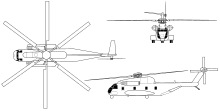
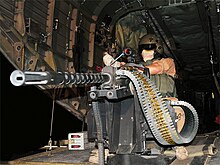

Data from Deagel.com,[111] U.S. Navy history,[112] International Directory,[5] US Navy Fact File[113][114]
General characteristics
- Crew: 2 pilots, 1 or more loadmasters / crewmen
- Capacity: 38 troops (55 in alternate configuration) or 24 stretchers / 8,000 lb (3,600 kg) payload
- Width: 28 ft 4 in (8.64 m) over stub wings
- 15 ft 6 in (5 m) across fuselage
- Empty weight: 23,628 lb (10,717 kg)
- Gross weight: 33,500 lb (15,195 kg)
- Max takeoff weight: 42,000 lb (19,051 kg)
- Powerplant: 2 × General Electric T64-GE-413 turboshaft engines, 3,925 shp (2,927 kW) each
- Main rotor diameter: 72 ft 2.8 in (22.017 m)
- Main rotor area: 4,098.1 sq ft (380.73 m2) 6-bladed main rotor
- Blade section: – NACA 0011 mod[115]
Performance
- Maximum speed: 170 kn (200 mph, 310 km/h)
- Cruise speed: 150 kn (170 mph, 280 km/h)
- Range: 540 nmi (620 mi, 1,000 km)
- Combat range: 95 nmi (109 mi, 176 km)
- Ferry range: 886 nmi (1,020 mi, 1,641 km)
- Service ceiling: 16,750 ft (5,110 m)
- Rate of climb: 2,460 ft/min (12.5 m/s)
- Disk loading: 8.95 lb/sq ft (43.7 kg/m2)
Armament
- Two door mounted .50 BMG GAU-15/A machine guns. Some have a ramp mounted .50 BMG GAU-21 machine gun.
- German CH-53Gs can mount two 7.62×51mm MG3 machine guns in the side doors, which are to be replaced by two .50 BMG M3M/GAU-21 machines guns in the doors and one on the ramp.
See also
[edit]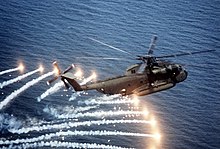
Related development
- Sikorsky CH-53E Super Stallion
- Sikorsky CH-53K King Stallion
- Sikorsky CH-54 Tarhe
- Sikorsky HH-53 "Super Jolly Green Giant"/MH-53 Pave Low
- Sikorsky S-61R
Aircraft of comparable role, configuration, and era
Related lists
- List of active United States military aircraft
- List of military aircraft of the United States
- List of rotorcraft
References
[edit]Citations
[edit]- ^ a b "End of an Era for an Icon of Marine Aviation". aero-news.net. 12 August 2012. Retrieved 15 April 2013.
- ^ a b c d e f g h i j k l m n o p q r "S-65/H-53A/D Sea Stallion/ H-53E Super Stallion". sikorskyarchives.com. Retrieved 28 March 2021.
- ^ a b c d e f g h i j k l m n o p "S-65 Origins / US Marine CH-53A & CH-53D Sea Stallion". Airvectors.net, 1 January 2016.
- ^ a b c d e f Carter, Edward S. Jr. (September 1965). "Technological contributions of the ch-53a transport helicopter development program". Journal of Aircraft. 2 (5): 430–436. doi:10.2514/3.43679.
- ^ a b c d Frawley 2002, p. 148.
- ^ Donald, David, ed. "Sikorsky S-65". The Complete Encyclopedia of World Aircraft. Barnes & Noble Books, 1997. ISBN 0-7607-0592-5.
- ^ a b USAF HH-53B, HH-53C, & CH-53C, Vectorsite.net, 1 May 2006.
- ^ a b Dunham, George R (1990). U.S. Marines in Vietnam: The Bitter End, 1973–1975 (Marine Corps Vietnam Operational Historical Series). History and Museums Division Headquarters, U.S. Marine Corps. ISBN 978-0-16-026455-9.
 This article incorporates text from this source, which is in the public domain.
This article incorporates text from this source, which is in the public domain.
- ^ Gargus 2007, pp. 284-288.
- ^ Wetterhahn 2002, p. 26.
- ^ Carter (1982), p. 519.
- ^ Buck, Peter (2015). The Iranian Hostage Rescue Attempt: A Case Study. Pickle Partners. ISBN 978-1782899686.
- ^ Kreisher, Otto. "Operation URGENT FURY – Grenada". Marine Corps Association & Foundation. Archived from the original on 19 April 2016. Retrieved 6 April 2016.
- ^ "US Marine Corps retires CH-53D". Rotorhub, 24 February 2012.
- ^ Montgomery, Dave (19 September 2007). "1st squadron of V-22s quietly deployed to Iraq". Naval Air Systems Command. United States Navy. Archived from the original on 27 July 2009. Retrieved 1 December 2008.
- ^ "Sikorsky Awarded $3.0B Development Contract For Marine Corps CH-53K Heavy-Lift Helicopter" Archived 27 November 2008 at the Wayback Machine. Sikorsky Aircraft, 5 April 2006.
- ^ "New Heavy Lift Helicopter Starts Development". U.S. Marine Corps, 9 January 2006.
- ^ Gidget Fuentes (26 September 2011). "Hawaii move marks the end for vintage CH-53s". Army Times. Archived from the original on 30 September 2011. Retrieved 26 September 2011.
- ^ "Marine Corps squadron flies final tour with Vietnam-era helicopter in Afghanistan". Archived from the original on 16 November 2011. Retrieved 20 March 2012.
- ^ ""Ugly Angels" deactivate after 60 years of service". dvidshub.net. Retrieved 27 March 2018.
- ^ a b c d e f "Sikorsky CH-53 ("Yas'ur" (Petrel))". Israeli Air Force. Retrieved 28 March 2021.
- ^ Operation “Rooster”— Israel Captures Egyptian Radar In War of Attrition. Jewish Virtual Library. Retrieved 16 March 2008.
- ^ "Security and Defense: Coordinating capabilities". The Jerusalem Post. 12 August 2011.
- ^ "Israel studies CH-53 shoot-down". FlightGlobal. 6 August 2006.
- ^ Greenberg, Hanan (12 August 2006). "Hizbullah shoots down helicopter in southern Lebanon". Ynet.
- ^ Cordesman, A.H.; Sullivan, W.D.; Sullivan, G. (2007). Lessons of the 2006 Israeli-Hezbollah War. Significant issues series. CSIS Press. p. 122. ISBN 978-0-89206-505-9.
However, the IAF lost only one aircraft in combat and four in accidents. Three AH-64 Apaches were lost. One, a AH-64 Longbow that was lost as a result of a technical problem, and two AH-64 were lost in a midair collision caused by pilot error. An F-16 crashed during takeoff after a tire failure. The only combat loss was a CH-53 transport helicopter that have just unloaded troops and was struck during take off by a Chinese QW-1 light SAM
- ^ Egozi, Arie. "Israeli air force grounds CH-53 fleet after emergency landing." Flight International, 17 August 2012.
- ^ Egozi, Arie (21 March 2020). "Israel faults relay switch, Lockheed for CH-53 fire". verticalmag.com.
- ^ Israeli air force looks for lift from CH-53K FlightGlobal, 10 August 2015.
- ^ Ahronheim, Anna (2 August 2018). "Two Defense Companies Compete to Replace Israel's Heavy-Lift Helicopters". The Jerusalem Post. Archived from the original on 7 February 2018.
- ^ "Israel selects CH-53K King Stallion as the IDF's new transport helicopter". The Times of Israel. Retrieved 25 February 2021.
- ^ Zitun, Yoav (25 February 2021). "IDF approves use of CH-53K King Stallion as its new cargo helicopter". Ynet.
- ^ "ASN Wikibase Occurrence # 346569". Aviation Safety Network.
- ^ "Yas'ur 2025 #985 "Condor" (from Hebrew). sky-high.co.il.
- ^ Channel 12 News program "Uvda" story: "The warriors from the aircraft that almost crashed speak" (from Hebrew). Mako.
- ^ "Helicopter carrying Israeli troops to south after Hamas assault was hit by explosive" . The Times of Israel, 15 October 2023
- ^ RH-53D Production List Retrieved 28 April 2012.
- ^ "Director of Singapore Firm Sentenced for Illegally Exporting Controlled Aircraft Components to Iran". justice.gov. 5 November 2009.
- ^ "Iran Plans to Use Captured American Copter Against U.S." medium.com. 22 February 2014.
- ^ a b c d Krueger, Alfred (November–December 1972), Air-Britain Digest (periodical), vol. 24, Air-Britain
- ^ Ray, Roland (14 December 2012). "Wir wollen Ihnen eine neue militärische Heimat bieten". Schwäbische Zeitung (in German). Retrieved 6 January 2013.
- ^ Sprenger, Sebastian (14 January 2020). "Lockheed, Boeing enter Germany's heavy transport helicopter race". defensenews.com.
- ^ Newdick, Thomas (29 September 2020). "Germany Axes Plan To Buy Either Sikorsky CH-53K Or Boeing CH-47 Helicopters". thedrive.com.
- ^ Twitter Germany in USA, 5 July 2023, retrieved 5 July 2023
- ^ "BBC News | Europe | Avalanche rescuers find girl's body". news.bbc.co.uk. Retrieved 3 April 2024.
- ^ Medellin, Jorge Alejandro (27 April 2006). "Entrega Israel a Mexico helicopteros militares". El Universal. Mexico City.
- ^ Barzilai, Amnon (19 December 2003). "Mexico Buys 2 Missile Ships, 4 Choppers, for $90m". Haaretz.
- ^ a b Roa, Adrian (21 November 2015). "Desmentelan un helicopter CH-53 de la Sedenna donado al Estado de Hidalgo". infodefensa.com.
- ^ Rosenlof, Kim (31 January 2007). "Heavy Lift 'Fire Stallions' ready for firefighting duty". ainonline.com.
- ^ Archer, Michael (23 August 2020). "The Saga of the CH-53D 'FIRE STALLIONS'". airattackmag.com.
- ^ John Pike. "RH-53D". globalsecurity.org.
- ^ a b c Sikorsky H-53 Sea Stallion Archived 8 June 2017 at the Wayback Machine. Retrieved 28 April 2012.
- ^ a b Eden, Paul. "Sikorsky H-53", Encyclopedia of Modern Military Aircraft. Amber Books, 2004. ISBN 1-904687-84-9.
- ^ "Mittelständische Luftfahrtindustrie als zuverlässigen Partner fördern" (PDF) (in German). 8 August 2005. Archived from the original (PDF) on 24 December 2010. Retrieved 21 April 2009.
- ^ a b Modernisierte Hubschrauber für Afghanistan-Einsatz, bundeswehr.de. (English translation.)
- ^ a b "Germany Upgrading Its CH-53G Helicopters". Defense Industry Daily, 21 June 2009.
- ^ Hoyle, Craig. "Eurocopter gets personnel recovery deal for German army CH-53s". Flight International, 23 June 2009.
- ^ "Eurocopter signs contract to retrofit 26 CH53 Bundeswehr helicopters for personnel recovery missions "[permanent dead link]. Eurocopter, 18 June 2009.
- ^ Hoyle, Craig. "German army CH-53GA prototype flies". Flight International, 11 February 2010.
- ^ "German Heeresflieger order CH-53 upgrade" Archived 22 June 2008 at the Wayback Machine. Flug Revue, 25 February 2007.
- ^ "Israel starts testing upgraded CH-53 assault helicopter". 5 January 2009.
- ^ "The Yas'ur Helicopter Will Live Another Century" (from Hebrew). IAF official website.
- ^ Israel acquires surplus CH-53 helicopters for spares – FlightGlobal, 25 January 2013
- ^ a b c d "World Air Forces 2014" (PDF). Flightglobal Insight. 2014. Retrieved 19 May 2014.
- ^ "World's Air Forces – 1981". FlightGlobal. Retrieved 19 May 2014.
- ^ "Heer und Luftwaffe tauschen Hubschrauber". Flugrevue. 14 December 2012. Archived from the original on 12 April 2013. Retrieved 17 January 2013.
- ^ Ray, Roland (11 January 2013), "Bundeswehr: 1200 Dienstposten bleiben in Laupheim", Schwäbische Zeitung (in German), retrieved 23 March 2013
- ^ "RH-53D Sea Stallion". airvictorymuseum.com. Archived from the original on 23 May 2013. Retrieved 26 July 2013.
- ^ "Yas'ur 471 - Markia Schakim" (from Hebrew). sky-high.co.il
- ^ "Outdoor Exhibits Archives". NNAM. 5 June 2020. Retrieved 15 June 2024.
- ^ "ASN Wikibase Occurrence #74276". Aviation Safety Network. Retrieved 4 October 2017.
- ^ "ASN Wikibase Occurrence #76027". Aviation Safety Network. Retrieved 4 October 2017.
- ^ "ASN Wikibase Occurrence #138150". Aviation Safety Network. Retrieved 4 October 2017.
- ^ "ASN Wikibase Occurrence #148200". Aviation Safety Network. Retrieved 4 October 2017.
- ^ "ASN Wikibase Occurrence #148202". Aviation Safety Network. Retrieved 4 October 2017.
- ^ "ASN Wikibase Occurrence #148203". Aviation Safety Network. Retrieved 4 October 2017.
- ^ "ASN Wikibase Occurrence #148201". Aviation Safety Network. Retrieved 4 October 2017.
- ^ "ASN Wikibase Occurrence #148205". Aviation Safety Network. Retrieved 4 October 2017.
- ^ "ASN Wikibase Occurrence #148207". Aviation Safety Network. Retrieved 4 October 2017.
- ^ "ASN Wikibase Occurrence #148208". Aviation Safety Network. Retrieved 4 October 2017.
- ^ "ASN Wikibase Occurrence #56222". Aviation Safety Network. Retrieved 4 October 2017.
- ^ "ASN Wikibase Occurrence #148206". Aviation Safety Network. Retrieved 4 October 2017.
- ^ "ASN Wikibase Occurrence #56221". Aviation Safety Network. Retrieved 4 October 2017.
- ^ "ASN Wikibase Occurrence #148204". Aviation Safety Network. Retrieved 4 October 2017.
- ^ "ASN Wikibase Occurrence #56218". Aviation Safety Network. Retrieved 4 October 2017.
- ^ Dunham, George R (1990). U.S. Marines in Vietnam: The Bitter End, 1973-1975 (Marine Corps Vietnam Operational Historical Series). Marine Corps Association. p. 240. ISBN 9780160264559.
 This article incorporates text from this source, which is in the public domain.
This article incorporates text from this source, which is in the public domain.
- ^ Wetterhahn 2002, pp. 195–177.
- ^ "Info About a 1977 Helicopter Crash". Retrieved 4 January 2012.
- ^ "ASN Occurrence no. 55637". Aviation Safety Network. Retrieved 3 March 2013.
- ^ "V65-079". helis.com. Retrieved 23 March 2013.
- ^ "Marine Heavy Helicopter Squadron 777". 9 February 2024.
- ^ "Accident Sikorsky CH-53A Sea Stallion 153312". aviation-safety.net. Retrieved 9 February 2024.
- ^ "Starship 402 Memorial Taps Scholarship". Retrieved 9 February 2024.
- ^ "Court Ruling May Have Big Effect on Copter Crash Suits". Los Angeles Times. 15 January 1987. Retrieved 6 September 2011.
- ^ a b "'It's Getting Worse': Copter Victim's Tape Detailed Craft's Faults". Los Angeles Times. 14 May 1986. Retrieved 8 June 2012.
- ^ "Helicopter Crash Kills 1 Marine, Injures 5: Military: Mishap near the Salton Sea is latest in series of fatal accidents involving the aircraft. More than 200 servicemen have been killed in similar Sikorsky-built copters since 1969". Los Angeles Times. 20 May 1990. Retrieved 8 June 2012.
- ^ Archives, L. A. Times (20 March 1989). "22 U.S. Marines Die in S. Korea Copter Crash: 15 Hurt, Some Critically, as CH-53 Sea Stallion Falls in Mountain Area". Los Angeles Times. Retrieved 8 November 2024.
- ^ "Helicopter Crash Kills 1 Marine, Injures 5: Military: Mishap near the Salton Sea is latest in series of fatal accidents involving the aircraft. More than 200 servicemen have been killed in similar Sikorsky-built copters since 1969". Los Angeles Times. 20 May 1990. Retrieved 8 June 2012.
- ^ "1 Marine Killed, 4 Hurt in Crash of Tustin-Based Helicopter". Los Angeles Times. 14 March 1994. Retrieved 8 June 2012.
- ^ "Yas'ur 2000". Israeli.Weapons.com. Retrieved 10 March 2007.
- ^ Ray, Roland (21 December 2012). "Zehn Jahre nach dem Hubschrauberabsturz über Kabul: Soldaten sind nicht vergessen". Schwäbische Zeitung (in German). Retrieved 1 February 2013.
- ^ Michael Robert Patterson. "United States Helicopter Crew: Killed In Afghanistan, 23 November 2003". Arlingtoncemetery.net. Retrieved 2 May 2022.
- ^ Carol, Joe. "Futenma divides Okinawa's expats". The Japan Times, 8 June 2010.
- ^ "Bad memories of U.S. bases linger". The Japan Times, 29 April 2010.
- ^ Takahara, Kanako. "Missing pin caused copter crash: report". The Japan Times, 6 October 2004.
- ^ https://asn.flightsafety.org/wikibase/56016#:~:text=Accident%20Sikorsky%20CH%2D53E%20Super,you%20can%20submit%20corrected%20information.&text=Narrative:,Task%20Force%2DHorn%20of%20Africa.
- ^ "Deutscher Militärhubschrauber auf einer Höhe von 2.600 M. verunfallt" (in German). Kantonspolizei Obwalden. 28 November 2008. Retrieved 3 March 2013.
- ^ "Bundeswehr-Heli aus Titlisgebiet geborgen". 20 Minuten (in German). 26 June 2009. Retrieved 23 March 2013.
- ^ "Hawaii Local Breaking News and Headlines – 1 Marine dies, 3 injured in Kaneohe Bay crash". Honolulu Star-Advertiser. Archived from the original on 6 April 2015.
- ^ "U.S. copter crashes in Afghanistan; 6 dead". CBS News, 20 January 2012.
- ^ "CH-53D Sea Stallion". Deagel.com. Archived from the original on 21 September 2006. Retrieved 10 March 2007.
- ^ "CH-53A/D/E Sea Stallion and MH-53E Sea Dragon". United States Navy. Archived from the original on 6 February 1997. Retrieved 28 March 2021.
- ^ "CH-53D Fact File". United States Navy. 17 May 1999. Archived from the original on 14 November 2008. Retrieved 26 October 2007.
- ^ "Marines and Helicopters, 1962–1973" (PDF). marines.mil. Archived from the original (PDF) on 3 October 2012. Retrieved 27 March 2018.
- ^ Lednicer, David. "The Incomplete Guide to Airfoil Usage". m-selig.ae.illinois.edu. Retrieved 16 April 2019.
Bibliography
[edit]- Andrade, John (1982). Militair 1982. London: Aviation Press Limited. ISBN 0-907898-01-7.
- Carter, Jimmy (1 October 1982). Keeping Faith: Memoirs of a President. Bantam Books. ISBN 0-553-05023-0.
- Frawley, Gerard: The International Directory of Military Aircraft, page 148. Aerospace Publications Pty Ltd, 2002. ISBN 1-875671-55-2.
- Gargus, John (2007). The Son Tay Raid : American POWs in Vietnam Were Not Forgotten (first ed.). College Station: Texas A & M Univ. Press. ISBN 978-1-58544-622-3.
- Wetterhahn, Ralph (2002). The Last Battle: The Mayaguez Incident and the end of the Vietnam War. Plume. p. 26. ISBN 0-452-28333-7.
External links
[edit]- US Navy CH-53A/D/E and MH-53E history page Archived 6 February 1997 at the Wayback Machine and US Navy CH-53 fact file Archived 14 November 2008 at the Wayback Machine
- CH-53D/E Fact File and CH/RH-53D fact file on USMC site
- CH-53 Yas'ur (Israeli Air Force website)
- CH-53 Sea Stallion page on GlobalAircraft.org
- Sikorsky S-65 / H-53 Sea Stallion page on Helis.com
